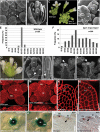Class I BASIC PENTACYSTEINE factors regulate HOMEOBOX genes involved in meristem size maintenance
- PMID: 24482368
- PMCID: PMC3967085
- DOI: 10.1093/jxb/eru003
Class I BASIC PENTACYSTEINE factors regulate HOMEOBOX genes involved in meristem size maintenance
Abstract
The BASIC PENTACYSTEINE (BCP) family is a poorly characterized plant transcription factor family of GAGA BINDING PROTEINS. In Arabidopsis, there are seven members (BPC1-7) that are broadly expressed, and they can potentially bind more than 3000 Arabidopsis GAGA-repeat-containing genes. To date, BPCs are known to be direct regulators of the INNER NO OUTER (INO), SEEDSTICK (STK), and LEAFY COTYLEDON 2 (LEC2) genes. Because of the high functional redundancy, neither single knockout nor double bpc mutant combinations cause aberrant phenotypes. The bpc1-2 bpc2 bpc3 triple mutant shows several pleiotropic developmental defects, including enlargement of the inflorescence meristem and flowers with supernumerary floral organs. Here, we demonstrated through expression analysis and chromatin immunoprecipitation assays that this phenotype is probably due to deregulation of the expression of the SHOOTMERISTEMLESS (STM) and BREVIPEDICELLUS/KNAT1 (BP) genes, which are both direct targets of BPCs. Moreover, we assigned a role to BPCs in the fine regulation of the cytokinin content in the meristem, as both ISOPENTENYLTRANSFERASE 7 (IPT7) and ARABIDOPSIS RESPONSE REGULATOR 7 (ARR7) genes were shown to be overexpressed in the bpc1-2 bpc2 bpc3 triple mutant.
Keywords: Arabidopsis; BPC; HOMEOBOX; cytokinin; meristem..
Figures




Similar articles
-
Basic pentacysteine proteins mediate MADS domain complex binding to the DNA for tissue-specific expression of target genes in Arabidopsis.Plant Cell. 2012 Oct;24(10):4163-72. doi: 10.1105/tpc.112.103952. Epub 2012 Oct 9. Plant Cell. 2012. PMID: 23054472 Free PMC article.
-
Specification of reproductive meristems requires the combined function of SHOOT MERISTEMLESS and floral integrators FLOWERING LOCUS T and FD during Arabidopsis inflorescence development.J Exp Bot. 2011 Jan;62(2):583-93. doi: 10.1093/jxb/erq296. Epub 2010 Oct 11. J Exp Bot. 2011. PMID: 20937733 Free PMC article.
-
The Arabidopsis homeobox gene SHOOT MERISTEMLESS has cellular and meristem-organisational roles with differential requirements for cytokinin and CYCD3 activity.Plant J. 2013 Jul;75(1):53-66. doi: 10.1111/tpj.12198. Epub 2013 May 16. Plant J. 2013. PMID: 23573875
-
Inside the gynoecium: at the carpel margin.Trends Plant Sci. 2013 Nov;18(11):644-55. doi: 10.1016/j.tplants.2013.08.002. Epub 2013 Sep 2. Trends Plant Sci. 2013. PMID: 24008116 Review.
-
Epigenetic Mechanisms Are Critical for the Regulation of WUSCHEL Expression in Floral Meristems.Plant Physiol. 2015 Aug;168(4):1189-96. doi: 10.1104/pp.15.00230. Epub 2015 Mar 31. Plant Physiol. 2015. PMID: 25829464 Free PMC article. Review.
Cited by
-
Multifaceted regulatory functions of CsBPC2 in cucumber under salt stress conditions.Hortic Res. 2023 Mar 15;10(5):uhad051. doi: 10.1093/hr/uhad051. eCollection 2023 May. Hortic Res. 2023. PMID: 37213679 Free PMC article.
-
Comprehensive Analysis of Cucumber Gibberellin Oxidase Family Genes and Functional Characterization of CsGA20ox1 in Root Development in Arabidopsis.Int J Mol Sci. 2018 Oct 12;19(10):3135. doi: 10.3390/ijms19103135. Int J Mol Sci. 2018. PMID: 30322023 Free PMC article.
-
The Arabidopsis GAGA-Binding Factor BASIC PENTACYSTEINE6 Recruits the POLYCOMB-REPRESSIVE COMPLEX1 Component LIKE HETEROCHROMATIN PROTEIN1 to GAGA DNA Motifs.Plant Physiol. 2015 Jul;168(3):1013-24. doi: 10.1104/pp.15.00409. Epub 2015 May 29. Plant Physiol. 2015. PMID: 26025051 Free PMC article.
-
Characterizations of a Class-I BASIC PENTACYSTEINE Gene Reveal Conserved Roles in the Transcriptional Repression of Genes Involved in Seed Development.Curr Issues Mol Biol. 2022 Sep 7;44(9):4059-4069. doi: 10.3390/cimb44090278. Curr Issues Mol Biol. 2022. PMID: 36135190 Free PMC article.
-
Knowing When to Silence: Roles of Polycomb-Group Proteins in SAM Maintenance, Root Development, and Developmental Phase Transition.Int J Mol Sci. 2020 Aug 15;21(16):5871. doi: 10.3390/ijms21165871. Int J Mol Sci. 2020. PMID: 32824274 Free PMC article. Review.
References
-
- Ariel FD, Manavella PA, Dezar CA, Chan RL. 2007. The true story of the HD-Zip family Trends in Plant Science 124, 19–26 - PubMed
-
- Battaglia R, Brambilla V, Colombo L, Stuitje AR, Kater MM. 2006. Functional analysis of MADS-box genes controlling ovule development in Arabidopsis using the ethanol-inducible alc gene-expression system. Mechanisms of Development 123, 267–726 - PubMed
-
- Berger N, Dubreucq B. 2012. Evolution goes GAGA: GAGA binding proteins across kingdoms. Biochimica et Biophysica Acta 1819, 863–868 - PubMed
Publication types
MeSH terms
Substances
LinkOut - more resources
Full Text Sources
Other Literature Sources
Molecular Biology Databases
Research Materials

